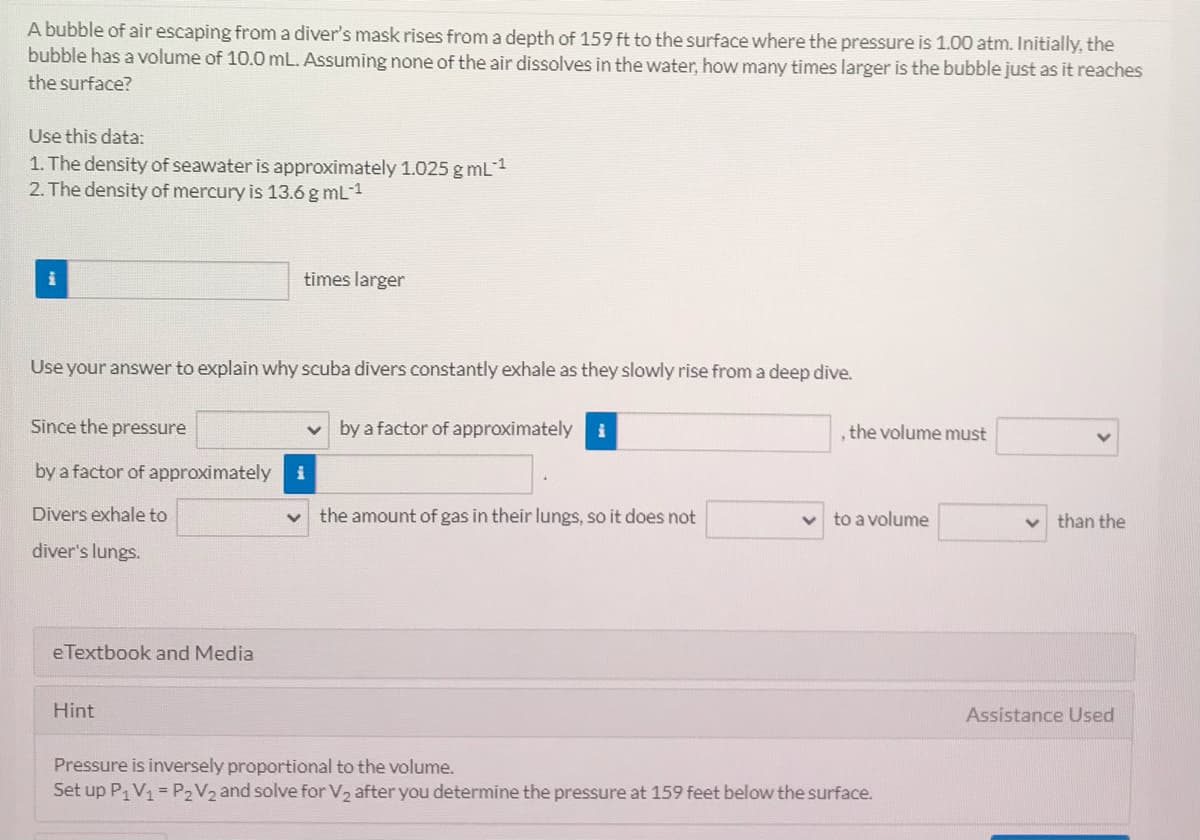A bubble of air escaping from a diver's mask rises from a depth of 159 ft to the surface where the pressure is 1.00 atm. Initially, the bubble has a volume of 10.0 mL. Assuming none of the air dissolves in the water, how many times larger is the bubble just as it reaches the surface? Use this data: 1. The density of seawater is approximately 1.025 g mL1 2. The density of mercury is 13.6 g mL-1 times larger Use your answer to explain why scuba divers constantly exhale as they slowly rise from a deep dive. Since the pressure by a factor of approximately , the volume must by a factor of approximately Divers exhale to the amount of gas in their lungs, so it does not to a volume v than the diver's lungs.
A bubble of air escaping from a diver's mask rises from a depth of 159 ft to the surface where the pressure is 1.00 atm. Initially, the bubble has a volume of 10.0 mL. Assuming none of the air dissolves in the water, how many times larger is the bubble just as it reaches the surface? Use this data: 1. The density of seawater is approximately 1.025 g mL1 2. The density of mercury is 13.6 g mL-1 times larger Use your answer to explain why scuba divers constantly exhale as they slowly rise from a deep dive. Since the pressure by a factor of approximately , the volume must by a factor of approximately Divers exhale to the amount of gas in their lungs, so it does not to a volume v than the diver's lungs.
Chemistry: An Atoms First Approach
2nd Edition
ISBN:9781305079243
Author:Steven S. Zumdahl, Susan A. Zumdahl
Publisher:Steven S. Zumdahl, Susan A. Zumdahl
Chapter10: Properties Of Solutions
Section: Chapter Questions
Problem 129CP: In some regions of the southwest United States, the water is very hard. For example, in Las Cruces,...
Related questions
Question

Transcribed Image Text:A bubble of air escaping from a diver's mask rises from a depth of 159 ft to the surface where the pressure is 1.00 atm. Initially, the
bubble has a volume of 10.0 mL. Assuming none of the air dissolves in the water, how many times larger is the bubble just as it reaches
the surface?
Use this data:
1. The density of seawater is approximately 1.025 g mL1
2. The density of mercury is 13.6 g mL-1
times larger
Use your answer to explain why scuba divers constantly exhale as they slowly rise from a deep dive.
Since the pressure
by a factor of approximately
i
, the volume must
by a factor of approximately
i
Divers exhale to
the amount of gas in their lungs, so it does not
to a volume
than the
diver's lungs.
eTextbook and Media
Hint
Assistance Used
Pressure is inversely proportional to the volume.
Set up P1V1 = P2V2 and solve for V2 after you determine the pressure at 159 feet below the surface.
Expert Solution
This question has been solved!
Explore an expertly crafted, step-by-step solution for a thorough understanding of key concepts.
Step by step
Solved in 3 steps

Knowledge Booster
Learn more about
Need a deep-dive on the concept behind this application? Look no further. Learn more about this topic, chemistry and related others by exploring similar questions and additional content below.Recommended textbooks for you

Chemistry: An Atoms First Approach
Chemistry
ISBN:
9781305079243
Author:
Steven S. Zumdahl, Susan A. Zumdahl
Publisher:
Cengage Learning

Chemistry
Chemistry
ISBN:
9781305957404
Author:
Steven S. Zumdahl, Susan A. Zumdahl, Donald J. DeCoste
Publisher:
Cengage Learning


Chemistry: An Atoms First Approach
Chemistry
ISBN:
9781305079243
Author:
Steven S. Zumdahl, Susan A. Zumdahl
Publisher:
Cengage Learning

Chemistry
Chemistry
ISBN:
9781305957404
Author:
Steven S. Zumdahl, Susan A. Zumdahl, Donald J. DeCoste
Publisher:
Cengage Learning


Chemistry: Principles and Reactions
Chemistry
ISBN:
9781305079373
Author:
William L. Masterton, Cecile N. Hurley
Publisher:
Cengage Learning

Chemistry: Principles and Practice
Chemistry
ISBN:
9780534420123
Author:
Daniel L. Reger, Scott R. Goode, David W. Ball, Edward Mercer
Publisher:
Cengage Learning

Principles of Modern Chemistry
Chemistry
ISBN:
9781305079113
Author:
David W. Oxtoby, H. Pat Gillis, Laurie J. Butler
Publisher:
Cengage Learning